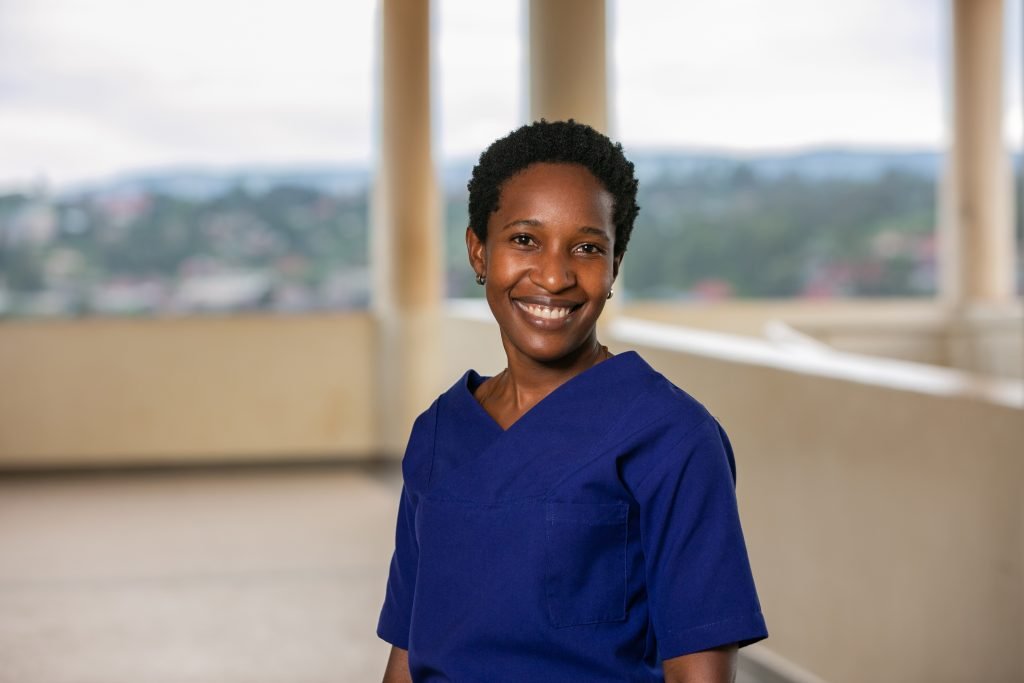John Bosco Kamugisha John Bosco Kamugisha is the Programme Coordinator for GEC in Uganda. Currently, …
The Hard Bargain To Save Lives

Dr. Prisca
Dr. Prisca Kizito is a GEC-sponsored EM physician and an assistant lecturer at Mbarara University of Science and Technology (MUST) in the emergency medicine department. In addition to training the diploma students, her role is to teach primarily post-graduate students and stretches to undergraduate students in their surgical rotation. Mostly done are bedside teaching and handling handover rounds, which are the essential bits of understanding and critical thinking in inpatient care. “Those rounds help us bring the diploma and post-graduate students together to think and work collaboratively as they are supervised. It allows for the discussion of important and intriguing cases so that we can enhance the learning process,” she says.
Her training in EM was one arduous journey. Like any new venture, paving the way for a new profession in a country where EM is barely visible was a daunting task. “Being the pioneer class, we were literally the guinea pigs for the master of EM course. We had to be prepared, opened minded, persistent, and goal-oriented to learn in terms of academics and to grow as a person,” she says. It was not easy for them because of limited resources. Theirs was a class of five students with four or five modules per semester, one full-time lecturer supported by a visiting lecturer, and limited teaching materials. “We learned to live within our means and to improvise with what was available, which was challenging. I grew emotionally and became self-aware,” she says. They had to build and foster relationships with lecturers from the traditional departments to have their modules delivered to progress in the course.
Undertaking the course stretched her, pushing her beyond every kind of comfort that she had known. “This is a full-time course away from home. I had to hand over my initial responsibilities like work, leave family and friends behind, and everything that was familiar to me to move to a new region in Uganda to undertake the course. It was a tough decision to move,” she recalls. It was also a choice between earning an income and studying. For her, it meant no source of income, no parties, and the like to focus on work, work, and more work. “It was so tiring… The three years weren’t easy, but we are so glad it is all done,” she says with a big sigh of relief.
But the struggle is not yet over. “Our biggest need is academic resources and training equipment to enable repetitive action for effective learning and the gaining of competencies. We need more academic faculty to reduce the burden on the current team so that as lecturers, we can provide better support to our students,” she says. Prisca is also advocating for scholarships for EM professionals. She says, “This will motivate more professionals who would be in EM but are currently held back by limited finances.” There is also a need to formally structure EM professionals at all levels to create demand for EM professionals.
“EM has been the most engaging and interesting journey in my career,” she says, having joined the profession in 2017. She recalls a case of a 15-year-old child who came in with severe bradycardia (slowed-heart beat) of 18 beats per minute. She was on duty, and they searched for the underlying cause using every possible means, but nothing worked. They managed with their usual procedures (atropine and adrenaline), but every time they would stop the drugs, the boy would fall back and get reduced blood flow to the rest of his body. “I remember staying overnight, watching to see how the child could be helped because I knew that this condition could be reversed at the Uganda Heart Institute in Kampala, some 269.5kms away. We found an ambulance and put the boy on adrenaline for the whole journey of 5 hours. For the risk and benefit analysis… well, we just wanted the boy alive so that he could get the specialist care that he needed,” she says. About two days later, she received information that the child had survived, received treatment, and was alive! “This experience was all a bargain for me because I could have easily given up given the obstacles. But then, I knew that this child could die if nothing was done. And yet he could live if someone could just do the right thing to put the heartbeat back to the right rate,” she beams with an infectious smile.
In Uganda, the call for life or death is usually a bargain because of inadequate emergency care. You can help us increase the chances of survival among vulnerable communities by donating to this cause. Click HERE to donate and feel free to tell someone about the cause!
This Post Has 0 Comments